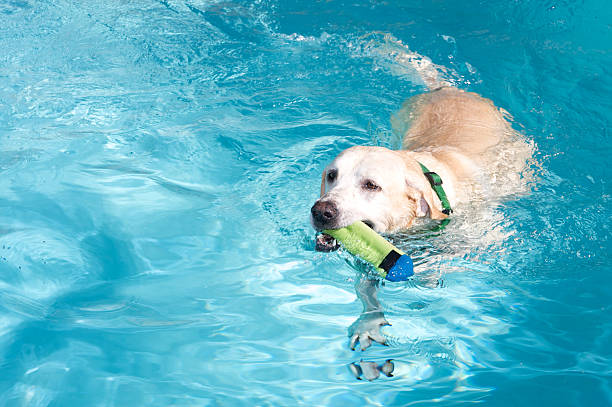Thinking about bringing a Labrador Retriever into your life? Good choice! The Lab has been America’s most popular dog breed for an impressive 30 consecutive years, according to the American Kennel Club. But how much do you actually know about these lovable furballs beyond their friendly faces and wagging tails?
Whether you’re a first-time dog parent researching your options or just an admirer of these amazing dogs, buckle up for some fascinating Lab facts that might surprise you!
They’re Not Actually From Labrador
Plot twist! Despite their name, Labrador Retrievers don’t actually come from Labrador, Canada. These dogs originated from the neighboring island of Newfoundland in the 1800s.
The original breed, known as St. John’s water dogs, were working companions to local fishermen. These hardworking pups would help retrieve fishing nets, pull ropes between boats, and even jump into the frigid North Atlantic to catch escaped fish!
When the Earl of Malmesbury brought these dogs back to England, he referred to them as “Labrador dogs” – and the name stuck, even when they gained popularity back in North America.
Born Water Dogs With Super Swimming Powers
Ever watched a Lab dive into water with pure joy? There’s a good reason for that obsession – they were literally built for swimming!
These natural water dogs come equipped with:
- Webbed toes that work like flippers
- A thick, water-resistant double coat that keeps them warm and dry
- A powerful “otter tail” that serves as a rudder for steering
- An innate love for anything wet!
Their specialized coat is fascinating – the thick undercoat provides insulation while the outer layer repels water. This combination makes them practically waterproof and able to swim comfortably even in icy conditions. No wonder they excel at dock diving competitions!

Three Colors Only (Despite What You Might Hear)
Yellow, black, and chocolate – these are the only three officially recognized Labrador Retriever colors according to breed standards. Though you might see “silver,” “charcoal,” or “fox-red” Labs advertised by breeders, these aren’t separate color classifications.
Fox-red is actually considered a darker shade of yellow, while silver Labs are controversial in the breeding community. Most experts believe silver-coated Labs result from crossbreeding with Weimaraners rather than being pure Labradors.
Black Labs are genetically dominant, which is why they’re most common, followed by yellow, with chocolate being the rarest of the three standard colors.

The Longest-Living Lab Made It to 27 Years
While the average Labrador lives between 10-12 years, one remarkable Lab named Adjutant defied all odds. Born in England in 1936, Adjutant lived to the astonishing age of 27, making him one of the ten oldest dogs ever recorded!
For perspective, that’s like a human living well past 100. If you’re adopting a Lab puppy, just imagine – with proper care and good genetics, your furry friend could potentially be with you for more than two decades!

Not Just Pretty Faces – They’re Working Geniuses
Labs aren’t just adorable family pets – they’re intelligent working dogs with an impressive resume. Their combination of smarts, trainability, and eagerness to please makes them perfect for specialized jobs:
- They make up almost 70% of all guide dogs for the visually impaired
- They excel in search and rescue operations
- They work as drug and bomb detection dogs
- They serve as therapy and emotional support animals
- They’re champions in hunting and retrieving
Their intelligence isn’t just for show – it requires an outlet! A bored Lab is a destructive Lab, so daily mental and physical stimulation is crucial for keeping these smart pups happy.
Speed Demons in Disguise
Don’t let their sometimes goofy demeanor fool you – Labs are impressively athletic. They can hit speeds of 12 miles per hour in just three seconds! Their powerful build and natural athleticism make them excellent running companions and competitors in dog sports like agility and field trials.
There Are English and American Varieties
Though they’re the same breed, Labradors come in two distinct types:
English (Show) Labs: These are the stockier, blockier-headed Labs with thicker coats and that signature “otter tail.” They tend to be calmer and were bred primarily for show rings.
American (Field) Labs: These are the more athletic, slimmer Labs with longer legs and narrower heads. They typically have more energy and were bred for hunting and fieldwork.
Both types make excellent companions, but knowing the difference can help you choose the right Lab for your lifestyle.

The Breed Almost Went Extinct
It’s hard to imagine a world without Labrador Retrievers, but the breed nearly disappeared in the late 1800s. In Newfoundland, heavy taxation and restrictions on dog ownership (limited to one dog per household) pushed St. John’s water dogs to the brink of extinction in Canada.
Thankfully, the breed survived in England, where British aristocrats had imported them for hunting. The first official Lab registration occurred in 1903, and the American Kennel Club recognized the breed in 1917.
They’re Legendary Food Enthusiasts
If you’ve ever owned a Lab, you know they have a special relationship with food – namely, they LOVE it! Their appetite is legendary, and their definition of “edible” is very broad. This food obsession is actually genetic – many Labs lack the gene that signals fullness, meaning they’ll keep eating even when they’re not hungry.
This insatiable appetite makes Labs particularly prone to obesity, so portion control and regular exercise are essential for keeping them healthy. A Lab will happily eat themselves into health problems if given the chance!
One Lab Was “Jailed” For Life
In one of history’s strangest dog tales, a black Lab named Pep was sentenced to life in Pennsylvania’s Eastern State Penitentiary in 1924. The official prison photograph shows Pep with his inmate number around his neck!
The story goes that Pep killed the Pennsylvania Governor’s wife’s cat and was sent to prison as punishment. However, the Governor later claimed Pep was actually sent there to serve as a morale-boosting mascot for the prisoners. Either way, Pep spent about 10 years “behind bars” and reportedly became good friends with the warden.

Are you ready to welcome a Labrador Retriever into your life? These intelligent, friendly, and energetic dogs make wonderful companions for active families. Just be prepared for wet floors after swimming sessions, endless games of fetch, and a dog that will steal your heart (and possibly your sandwich when you’re not looking).
Remember that adopting from a rescue is a great option – many Labs end up in shelters and deserve a second chance at a loving home. If you choose a breeder, look for one who performs all recommended health screenings and focuses on temperament over appearance.
Whatever color or type of Lab you choose, you’ll be getting a faithful companion with an eager-to-please attitude and a heart full of love!
Looking for information about other dog breeds? Check out our guides to Rhodesian Ridgebacks, Dachshunds, and other breeds on Pawtrix.wiki!



